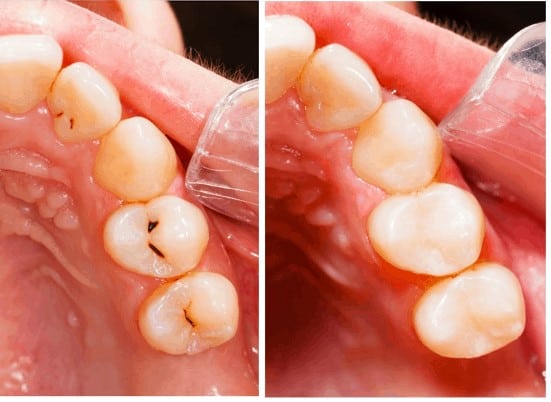
The materials used to restore a tooth with a cavity to natural shape and function have evolved considerably in the past few decades. Metals like gold and silver were once commonly used to fill teeth with cavities. Nowadays, in a world that places a high value on a white, bright smile, tooth-colored composite is the material of choice to repair decayed teeth while blending in with the rest of the teeth.
As a prosthodontist, Dr. Ashwini Bhave is passionate about designing and placing dental restorations that look, feel and function like natural, healthy teeth. When you meet with her to discuss filling a tooth or replacing an older filling, she thoroughly explains the advantages and drawbacks of composite fillings. This information empowers you to make informed decisions about your care.
What Is a Composite Filling?
Composite fillings are tooth-colored fillings made from plastic resin and a filler of finely ground glass particles. They provide the necessary level of protection to teeth with decay, and are strong and durable.
However, composite fillings are not recommended in every case. If a cavity is very large or located in an area of the mouth that is subject to considerable pressure when biting and chewing (i.e., the back molars), other treatment options may be explored.
Tooth-Colored Filling Treatment Details
Tooth-colored fillings can be placed in one dental appointment. The exact shade of composite resin is carefully selected to match the natural shade of the tooth being restored.
First, Dr. Bhave prepares your tooth for the composite filling by removing the decayed portion of tooth material. This leaves a space to be filled with the composite resin material. She applies a special bonding agent to the tooth to help ensure a strong bond between tooth and filling material. A curing light helps to set the bonding liquid.

Next, Dr. Bhave applies the composite material layer by layer to fill the prepared area of your tooth. She carefully sculpts the composite resin to match the contours of the tooth surface, and uses the curing light to harden each layer of the shaped composite. The shape of the filling needs to be just right to support a proper bite.
When Dr. Bhave is happy with her work, she polishes the filling to give it a light sheen that resembles natural tooth enamel.
Caring for Your New Filling
Fillings do not require any special care above and beyond what you would do for a natural tooth. In order to prevent more cavities, you should brush at least twice a day and floss daily. You should also avoid biting down on anything very hard (i.e., shells or ice) that could damage your filling or natural teeth. With the proper care, your composite filling can last for many years.
Tooth-colored Composite Fillings Vs Amalgam Fillings
There are various filling materials, and each comes with its own set of unique features. A major difference between tooth-colored composite fillings and amalgam fillings is their appearance. Whereas tooth-colored composite fillings can be closely matched to the color of the natural tooth, amalgams are highly visible and can create an unsightly greyish hue in the tooth. Additionally, amalgam fillings are associated with an increased risk of tooth fractures, and many patients are allergic to this material. Amalgams may also require the removal of a larger portion of the tooth, unlike tooth-colored composite fillings. Patients who desire an undetectable finish would benefit from composite fillings.
Preventing Cavities
The primary function of fillings is to restore the function of a tooth damaged from decay. However, you may be able to prevent cavities by:
Brushing after each meal: Brushing after every meal, but at least twice daily can help you effectively remove food debris from the surfaces of the tooth. Proper flossing removes particles that a toothbrush cannot reach and eliminates harmful plaque buildup near the gum line.
Using a mouthwash containing fluoride: Rinsing with a fluoride mouthwash can help reinforce the teeth, making them more resistant to tooth decay.
Attending regular dental appointments: During your regular dental appointments, your teeth and gums are thoroughly cleansed, and any signs of tooth decay can be identified and treated. To ensure your smile remains healthy, avoid skipping your dental appointments.
Avoiding a sugary diet: Regularly consuming foods that are high in sugar can make your teeth prone to tooth decay, as well as gum disease and tooth loss. For example, sticky foods that can get stuck in the contours of your teeth can lead to a buildup of harmful bacteria, eventually leading to cavities.
FAQs
What are the warning signs of cavities?
If cavities are left untreated, they can lead to tooth loss. This is why it is so important to recognize warning signs of cavities and seek treatment if you believe you have one. Symptoms include:
- Sharp tooth pain, especially when consuming sweet foods
- Sensitivity to hot or cold foods
- Dark spots on the tooth’s surface
- Pain when biting or chewing
- Tooth pain that occurs suddenly without an obvious cause
- Holes in the teeth
Will my filling look natural?

Will I feel any pain during my filling?
Dr. Bhave and his staff understand that some patients feel anxiety surrounding dental work. However, the compassionate and professional team at Bay Area Dental Specialists use all appropriate pain-minimizing methods to ensure patients have a comfortable experience while receiving excellent dental care.
How long do dental fillings last?
Dental fillings give you the confidence of a durable and restored smile. With proper care and maintenance, your dental fillings can last for years.
What are tooth-colored composite fillings?
Tooth-colored composite fillings are a type of dental filling made from a mixture of resin and finely ground glass particles. They are designed to match the natural color of your teeth, making them virtually unnoticeable. Composite fillings bond directly to the tooth, providing a strong and aesthetically pleasing result.
Why should I choose composite fillings over metal fillings?
Composite fillings offer several advantages over metal fillings, including:
Aesthetic Appeal: They blend seamlessly with your natural teeth, making them ideal for visible areas of your mouth.
Preservation of Tooth Structure: Less drilling is needed compared to metal fillings, allowing more of your natural tooth structure to remain intact.
Bonding Strength: Composite fillings bond to the tooth surface, which helps strengthen the remaining tooth structure and reduces the risk of cracks or breaks over time.
How long do tooth-colored fillings last?
The lifespan of a composite filling depends on factors like your oral hygiene, diet, and the size of the filling. On average, they last about five to 10 years with proper care. They are durable, provide a more natural appearance, and are composed of safer material.
Are tooth-colored fillings safe?
Yes, tooth-colored composite fillings are considered safe. They do not contain mercury or other metals commonly found in older amalgam fillings. The materials used in composite fillings are biocompatible and have been widely used in modern dentistry for years without safety concerns.
What should I expect after getting a composite filling?
After the procedure, you may experience some sensitivity to hot or cold temperatures, but this usually subsides within a few days. You should be able to resume normal eating and drinking shortly after the filling is placed. To ensure your filling lasts as long as possible, continue practicing good oral hygiene, including brushing twice a day, flossing, and regular dental check-ups.
How do I care for my composite fillings?
Caring for composite fillings is similar to caring for your natural teeth. To maintain their appearance and durability:
Brush your teeth at least twice a day with fluoride toothpaste.
Floss daily to prevent plaque buildup around the filling.
Avoid chewing on hard objects like ice or pens, as this can damage the filling.
Schedule regular dental check-ups and cleanings to monitor the health of your fillings and overall oral health.
Can composite fillings be used for large cavities?
Composite fillings are typically ideal for small to medium-sized cavities. For larger cavities, other restoration options, such as dental crowns or inlays, may be more appropriate as they offer greater strength and support. Your dentist at Bay Area Dental Specialists will evaluate your specific case and recommend the best treatment option for you.
How can I schedule a consultation for composite fillings?
If you’re considering tooth-colored composite fillings or have more questions about the procedure, we encourage you to schedule a consultation at Bay Area Dental Specialists. Our experienced dental team will assess your oral health and recommend the best treatment options to restore and enhance your smile.
Learn More About Tooth-Colored Fillings
Are you wondering which type of filling is right for you, and whether you could benefit from tooth-colored fillings? The first step is to consult with an experienced prosthodontist like Dr. Bhave, who can explain more about the benefits of each type of filling. Please request an appointment with Dr. Bhave by calling or emailing our office today.



